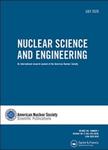版权所有:内蒙古大学图书馆 技术提供:维普资讯• 智图
内蒙古自治区呼和浩特市赛罕区大学西街235号 邮编: 010021

作者机构:Emory Univ Div Radiat Oncol Atlanta GA 30322 USA Argonne Natl Lab Nucl Sci & Engn Div 9700 S Cass Ave Argonne IL 60439 USA North Carolina State Univ Dept Nucl Engn Raleigh NC 27607 USA
出 版 物:《NUCLEAR SCIENCE AND ENGINEERING》 (Nucl Sci Eng)
年 卷 期:2020年第194卷第8-9期
页 面:650-664页
核心收录:
学科分类:08[工学] 0827[工学-核科学与技术]
基 金:U.S. Department of Energy via the Consortium for Advanced Simulation of Light Water Reactors [DE-AC05-00OR22725] Nuclear Energy University Program Integrated Research Project [DENE0008530] U.S. Department of Energy [DEAC02-06CH11357]
主 题:Data-driven turbulence modeling deep learning flow feature coverage mapping machine learning RANS
摘 要:Reynolds-Averaged Navier-Stoke (RANS) models offer an alternative avenue in predicting flow characteristics when the corresponding experiments are difficult to achieve due to geometry complexity, limited budget, or knowledge. RANS models require the knowledge of subgrid scale physics to solve conservation equations for mass, energy, and momentum. Mechanistic turbulence models, such as k-epsilon, are generally evaluated and calibrated for specific flow conditions with various degrees of uncertainty. These models have limited capability to assimilate a substantial amount of data due to model form constraints. Meanwhile, deep learning (DL) has been proven to be universal approximators with the potential to assimilate available, relevant, and adequately evaluated data. Moreover, deep neural networks (DNNs) can create surrogate models without knowing function forms. Such a data-driven approach can be used in updating fluid models based on observations as opposed to hard-wiring models with precalibrated correlations. The paper presents progress in applying DNNs to model Reynolds stress using two machine learning (ML) frameworks. A novel flow feature coverage mapping is proposed to quantify the physics coverage of DL-based closures. It can be used to examine the sufficiency of training data and input flow features for data-driven turbulence models. The case of a backward-facing step is formulated to demonstrate that not only can DNNs discover underlying correlation behind fluid data but also they can be implemented in RANS to predict flow characteristics without numerical stability issues. The presented research is a crucial stepping-stone toward the data-driven turbulence modeling, which potentially benefits the design of data-driven experiments that can be used to validate fluid models with ML-based fluid closures.